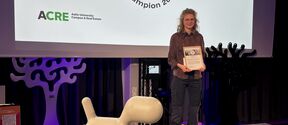Green and urban campus
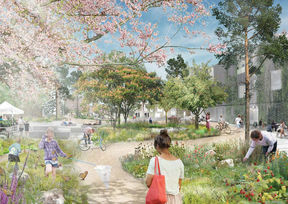
Parents pushing prams, food outlets and restaurants, outdoor sport and exercise facilities, urban cultivation plots, and plenty of new homes. There’s life after 5 pm. This is the vision that Aalto University’s Campus Curator Heini-Emilia Saari has for the future of Otaniemi.
‘Future Otaniemi will be a living-breathing part of the city. People live and work here in increasingly diverse ways and in greater numbers than before’, she says.
The City of Espoo plans to develop housing for 7,000 people in the area. The eventual aim is that approximately half of Otaniemi’s residents will be students.
In addition to the residential developments, numerous other buildings will be erected. These will be used by the university and its collaborative partners. For example, work on the new Student Centre is set to begin soon. The building is intended for use by the university’s student bodies and is situated opposite Harald Herlin Learning Centre and the Metro station.
Transportation connections will also be modernised. Plans are already in place for the Jokeri Light Rail to wind its way around Otaniemi by 2024. It is clear that plans to update the outdoor areas across the whole campus are needed. Aalto University has commissioned landscape architecture firm SLA to draw up plans for the wide array of environments in Otaniemi.
‘SLA has come up with plans for Otaniemi to become a network of interwoven and interconnected green areas. The idea is that different kinds of exercise and recreational spaces will be spread throughout this network. In this way, somewhat disparate areas will be seamlessly connected to each other’, says Kari Talvitie, Director of Property Development at Aalto University Campus & Real Estate (ACRE).
SLA specialises in sustainable environmental planning. In 2016, the firm won the Nordic Built Cities Challenge.
Even more natural diversity
A myriad of verdant environments will dissect the proposed green network; ranging from the completely natural to fully landscaped urban gardens.
‘In other words, biodiversity in Otaniemi is set to increase. In addition to preserving what is already there, by diversifying the natural environments the aim is to enrich the site. Currently, the green spaces are either entirely covered by lawns or have not been cultivated at all. More variation is needed’, Saari says.
Sustainability Manager Satu Kankaala (ACRE) is enthusiastic about the proposal to utilise useful plants.
‘There’s no reason why the trees on the site shouldn’t bear edible fruit. The yield of apples, plums, and berries could benefit everyone on site’, she notes.
According to Kankaala, the site’s biodiversity will be considered much more carefully than ever before. One example of this is the decision to no longer plant non-native species.
A pedestrianised city
The central premise behind the development of green areas is the creation of appealing environments that encourage people to leave their buildings and continue learning outdoors. The corridors and connecting pathways of both the in- and outdoor spaces on the site are being reimagined as meeting places.
‘The hope is that people working and studying in different fields will spontaneously meet each other simply by being outside. We have people from the fields of business, technology, and the arts all making use of the site. They are from industry and the university’, Talvitie says.
In addition to the plans for a more biodiverse campus, another important factor is that it will become a more pedestrian-friendly urban environment.
‘Currently, cars and car parks dominate this part of the city. In the future, it will be much easier to go from one place to another on foot or by bike. The pedestrian and cycle routes have been well thought-out and will encourage people to get out and enjoy the outdoor environments’, Saari says.
‘Another benefit of the plans is that the travel time between different parts of the campus will be less. In the future, the university’s units will be closer to each other’, Talvitie continues.
In this vision, Otaniemi becomes a coherent urban hub, surrounding both the university and the Metro station. The intention is to delineate the particular characteristics and flora of other parts of the area. Every nook and cranny will be a little bit different and recognisable in its own right, much in the same way as a municipal district or neighbourhood.
Future-proofing
Considering alternative visions is vital for environmental planning.
‘Nobody knows what the future holds for cars. Are we going to be driving more or less? Now, we build multi-storey car parks above ground. If our fondness for cars decreases in the future, these ground-level car parks can be knocked down and something else can take their place. There is no point sticking to a single vision of the future that may become problematic when change takes place’, Talvitie notes.

It is precisely for this reason that landscape architecture must take climate change and its related factors into consideration. Increase in rainfall and high winds in Northern Europe are the result of global warming.
SLA has designed different solutions to cope with rain and melt water runoff, including water features and the use of permeable surface materials.
Another aspect considered by the proposed plans is the way in which vegetation locally affects the microclimates in the site’s various outdoor spaces. The flora chosen for the site will be able to provide protection from the harsh winds or even generate much needed cool air in the summer heat.
‘The need for a future-proofed and sustainable vision permeates every aspect of SLA’s designs. They have considered the impact of climate change, this ideal can be seen in the plans for pedestrianisation and making the outdoor areas comfortable and lush with urban verdancy’, Kankaala says.
Different perspectives
Various conditions had to be taken into consideration when planning the regeneration of Otaniemi.
A prime example of these is the Laajalahti Nature Reserve, which is home to an internationally-important wetland area, a migratory destination for numerous species of bird. The northern wheatear and corncrake can be spotted there if you look carefully. It is a stopping-off-point for flocks of birds during their spring and autumn migrations.
Otaniemi also boasts several examples of culturally and historically important architecture. The environment and buildings must complement each other.
Yet another important consideration for the landscape architects is the issue of land ownership. Although Aalto University and Senate Properties own the major share of the real estate, Otaniemi is also owned by several private landowners.
‘The City of Espoo also has its own plans for Otaniemi. And the planning work must address the perspectives of various stakeholders. There is one important issue on which all the landowners agree. They all view the many green areas as a strength’, Saari says.
Work begins
The landscape design work will be carried out gradually over a few years. Each time a new building goes up or other substantial changes are made to the environment, the design implementation for the outdoor spaces will be reconsidered.
The final regeneration of the site’s outdoor areas will begin to take shape from 2020 onwards. Work will first begin near the end of summer 2019, right at the heart of the Otaniemi campus area, around the Metro station, Alvar Square, and the Dipoli building.
Text: Anu Vallinkoski
Main image: SLA
This article was first published in Aalto University Campus journal in December 2018.
- Updated:
- Published: This content was originally published on www.aalto.fi.
Read more news
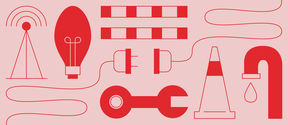
Temporary traffic arrangements on Lämpömiehenkuja and Metallimiehenkuja
The new arrangements will be implemented starting Monday, November 24, 2025.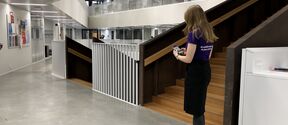
Accessible routes in Aalto Space application
You can also choose an accessible route for navigation on campus.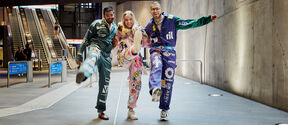
Use your voice: 14 000 euros for student wellbeing
In autumn 2025, students were asked to come up with ideas on how the university should spend 14 000 euros to improve student wellbeing on campus. Now it's time to vote for the best idea to be implemented during spring 2026.